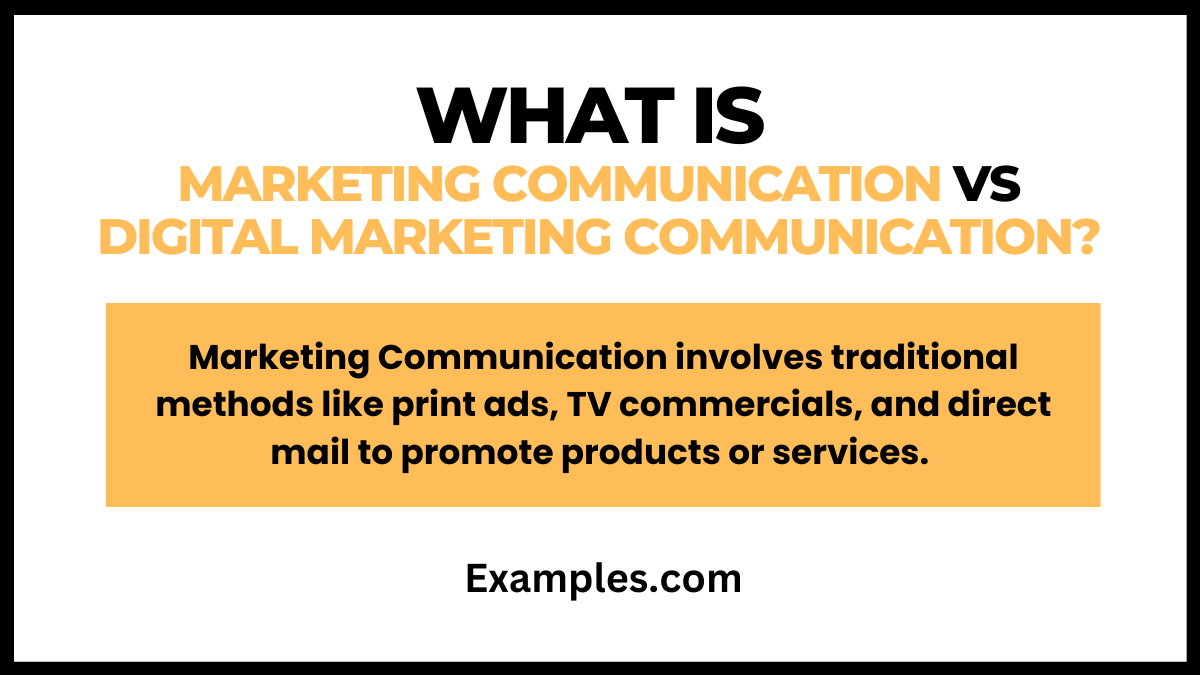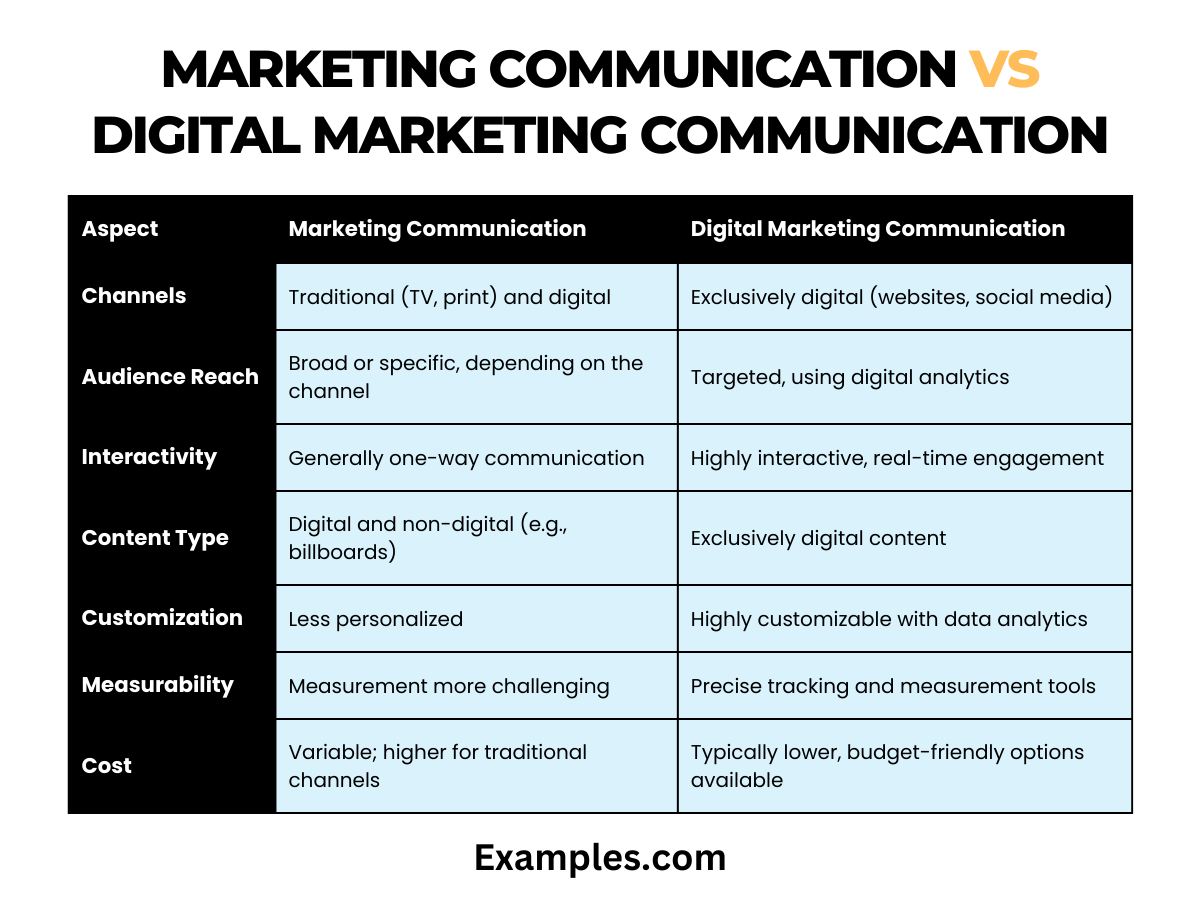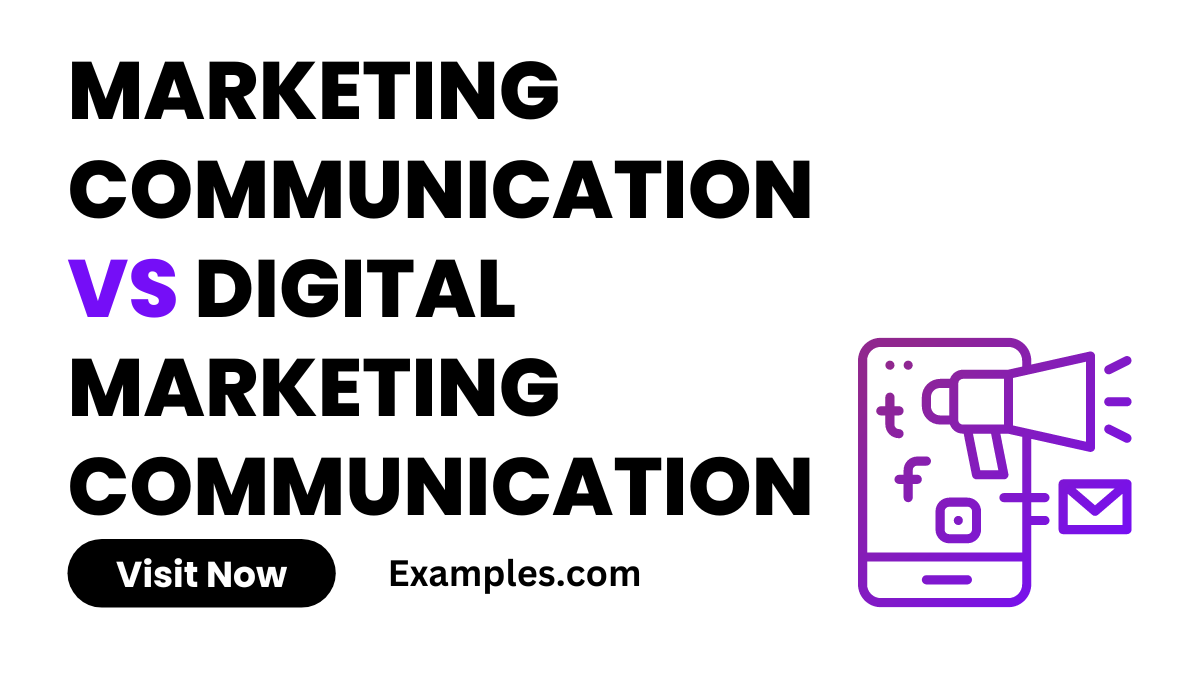Marketing Communication vs Digital Marketing Communication – 9+ Examples
Embark on a journey through the dynamic fields of Marketing Communication and Digital Marketing Communication. This comprehensive guide, brimming with various Marketing Communication Examples, delves into the core aspects of each discipline, highlighting their unique features and applications. Ideal for professionals and businesses alike, this guide provides valuable insights, from traditional marketing strategies to the latest digital trends, equipping you with the knowledge to excel in today’s multifaceted marketing landscape.
What is Marketing Communication vs Digital Marketing Communication?

Marketing Communication involves traditional methods like print ads, TV commercials, and direct mail to promote products or services. Digital Marketing Communication, however, uses digital channels like social media, websites, and email for promotion, focusing on reaching audiences online with interactive and targeted content.
Difference between Marketing Communication vs Digital Marketing Communication
To understand the nuances between Marketing Communication and Digital Marketing Communication, here’s a table that clearly delineates their distinct characteristics:

| Aspect | Marketing Communication | Digital Marketing Communication |
|---|---|---|
| Definition | Involves a broad range of communication strategies to promote a brand or product. | Focuses specifically on digital channels to market products or services. |
| Channels Used | Utilizes both traditional (TV, print, radio) and digital mediums. | Primarily uses digital platforms (social media, websites, email). |
| Reach | Can target both broad and specific audiences, depending on the channel. | Generally targets a more specific audience, tailored through digital analytics. |
| Interactivity | Traditionally more one-way communication. | Highly interactive, often allowing for real-time engagement. |
| Content Type | Includes both digital and non-digital content (e.g., billboards, flyers). | Exclusively digital content (e.g., online ads, social media posts). |
| Customization | Less personalized; often uses a one-size-fits-all approach. | Highly customizable, using data analytics for targeted messaging. |
| Measurability | More challenging to measure effectiveness accurately. | Offers precise tracking and measurement tools. |
| Speed of Implementation | Varies from immediate (digital ads) to longer (print media campaigns). | Typically faster, with the ability to launch campaigns quickly. |
| Cost | Can be high for traditional channels; variable for digital channels. | Often lower cost, with options for budget-friendly strategies. |
| Engagement | Engagement levels can be harder to gauge. | High engagement potential, with metrics to measure user interactions. |
| Feedback Loop | Slower feedback loop due to traditional channels. | Immediate feedback through online interactions and analytics. |
10 Examples of Marketing Communication
Marketing Communication encompasses a variety of strategies and channels to reach and engage audiences. Here are ten key examples:
- Print Advertising: Involves ads in newspapers, magazines, and brochures, offering a tangible medium for brand messaging.
- Television Commercials: Combines visual and audio elements for a broad reach, ideal for storytelling and brand building.
- Radio Broadcasting: Uses audio ads to reach local or specific demographic groups, often effective for community-based marketing.
- Outdoor Billboards: Large-scale ads in public places for high visibility, often used for brand awareness campaigns.
- Direct Mail: Personalized physical mail, like flyers and postcards, sent to targeted individuals or households.
- Trade Shows and Exhibitions: Opportunities for businesses to showcase products or services and interact directly with potential clients.
- Public Relations: Managing the spread of information to the public via media to build and maintain a positive image.
- Event Sponsorship: Associating a brand with events to enhance visibility and build goodwill among specific audience segments.
- Point of Sale Displays: In-store displays designed to catch consumer attention and influence purchase decisions at the point of sale.
- Personal Selling: One-on-one interaction between a sales representative and a potential customer, often used in B2B marketing.
10 Examples of Digital Marketing Communication
Digital Marketing Communication leverages online platforms and digital technologies to connect with audiences. Here are ten important examples:
- Social Media Marketing: Engaging with audiences on platforms like Facebook, Instagram, and LinkedIn through posts, ads, and community management.
- Content Marketing: Creating valuable content like blogs, videos, and infographics to attract and engage a target audience online.
- Email Marketing: Sending promotional or informational emails to a subscribed audience to nurture leads and maintain customer relationships.
- Search Engine Optimization (SEO): Optimizing website content to rank higher in search engine results, increasing visibility and organic reach.
- Pay-Per-Click Advertising (PPC): Ads on search engines or social media where payment is based on user clicks, offering targeted reach.
- Affiliate Marketing: Collaborating with individuals or companies to promote products or services in exchange for a commission.
- Influencer Marketing: Partnering with social media influencers to market products to their followers.
- Mobile Marketing: Reaching audiences through mobile devices via SMS marketing, mobile apps, and responsive web design.
- Webinars and Virtual Events: Hosting online events or seminars to educate, engage, and convert the target audience.
- Online Video Advertising: Utilizing video platforms like YouTube for advertising, offering engaging and shareable content formats.
Comparison Between Marketing Communication vs Digital Marketing Communication
In the evolving landscape of marketing, understanding the distinction between Marketing Communication and Digital Marketing Communication is crucial for crafting effective strategies. This guide delves into the key differences between these two approaches, providing insights into how they cater to diverse marketing needs.
- Medium and Reach: Marketing Communication often uses traditional channels like television, radio, print media, and outdoor advertising. Digital Marketing Communication leverages online platforms, including social media, websites, emails, and digital ads.
- Interactivity and Engagement: Digital Marketing Communication offers higher interactivity, allowing for real-time engagement and feedback through social media and online platforms. Traditional Marketing Communication is typically one-way communication.
- Targeting and Personalization: Digital marketing allows for more precise targeting and personalization using online user data, while traditional marketing often targets broader audiences.
- Cost and ROI Measurement: Digital marketing is generally more cost-effective and offers more measurable ROI compared to traditional marketing, which can be more expensive and harder to measure.
- Content Style and Format: Digital Marketing Communication often requires content that is concise, engaging, and adaptable for various digital formats, while traditional Marketing Communication can accommodate longer and more static content forms.
Relationship Between Marketing Communication vs Digital Marketing Communication
While Marketing Communication and Digital Marketing Communication are distinct, they are not mutually exclusive. In fact, their relationship is complementary, and understanding this synergy is vital for a comprehensive marketing strategy. This section explores how these two forms of communication can work together to enhance overall marketing effectiveness.
- Integrated Marketing Strategies: Businesses often combine traditional and digital marketing tactics for a more robust marketing strategy, leveraging the strengths of each.
- Brand Consistency Across Channels: Ensuring consistent messaging across both digital and traditional platforms reinforces brand recognition and customer trust.
- Leveraging Data for Traditional Marketing: Insights gathered from digital marketing efforts can inform and optimize traditional marketing campaigns.
- Enhanced Customer Journey: By using both traditional and digital methods, companies can create a seamless customer experience from initial awareness through to purchase and loyalty.
- Adapting to Consumer Preferences: Understanding consumer preferences in media consumption can help businesses decide the right mix of traditional and digital tactics.
- Cross-promotional Opportunities: Digital platforms can be used to amplify traditional marketing efforts and vice versa, such as promoting a TV ad on social media.



